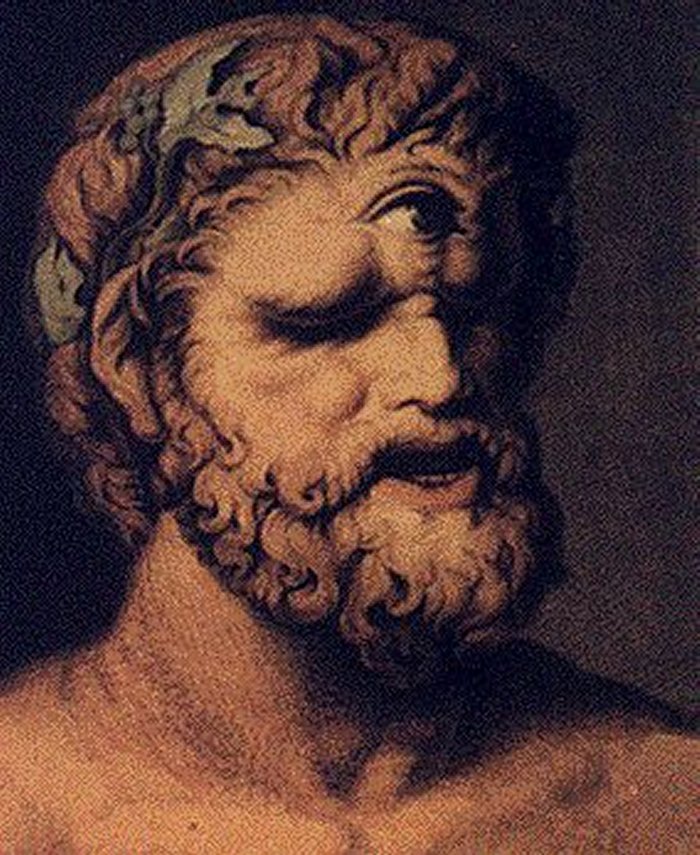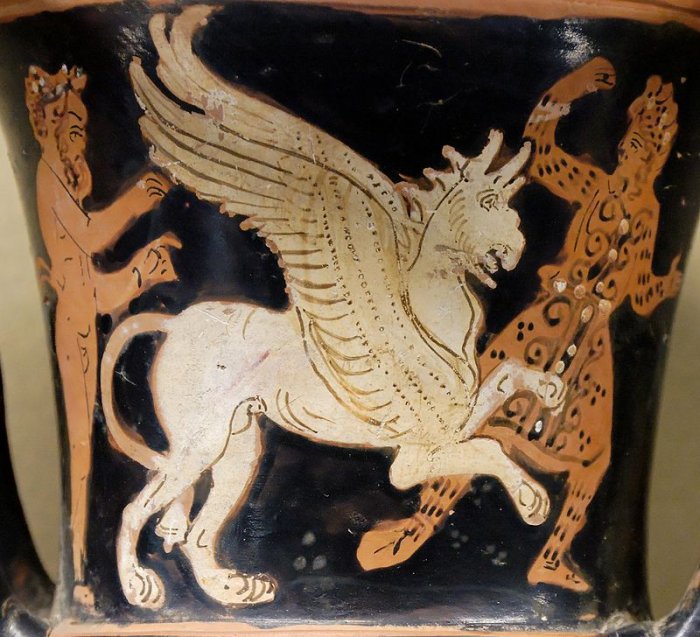Arimaspians: Mysterious Mighty Warriors With One-Eye
A. Sutherland - AncientPages.com - The Arimaspians were a tribe of ordinary human-sized horsemen with only one eye in the middle of their forehead. Based on ancient records, they inhabited land at the foot of the Riphean (Rhipaion) Mountains, a mountain range located far north of Eurasia.
Polyphemus, by Johann Heinrich Wilhelm Tischbein, 1802
Greek records, for example, mention the Inner Asian Arimaspians and refer to them as one-eyed beings in the Inner Asian tradition, found in the works of geographers from India and China, who wrote about the nomadic peoples of the steppe regions.
These people were involved in a long-lasting and practically never-ending struggle against griffins, legendary powerful creatures both feared and respected guardians of gold and treasures.
Herodotus gave information about the Arimaspians from the Argipeans, who inhabited the mountainous areas between the Scythians and the Issedones. He is not the first source of information about the mysterious Arimaspians.
In "The Discovery of America" Vol. 1 (of 2) by John Fiske, we read that "the first mention of these mythical people seems to have been made by Greek travelers in Scythia as early as the seventh century before Christ; and they furnished Aristeas of Proconnesus, somewhat later, with the theme of his poem "Arimaspeia," which has perished, all except six verses... quoted by Longinus. The notion of the Arimaspians seems to have passed to Herodotus (iii. 116; iv. 27).
It is in the third book of the Histories (116) that Herodotus makes his first mention of the Arimaspians — a race of beings deeply connected to tales of the abundance of gold in the "northern" parts of "Europe." However, he does not seem convinced of these mythical one-eyed men's existence.
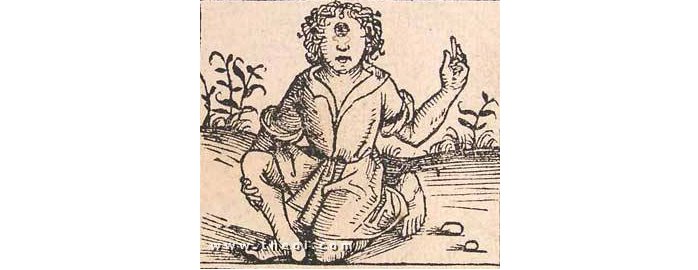 Arimaspian from the Nurenburg Chronicle, 1493. Image source
Arimaspian from the Nurenburg Chronicle, 1493. Image source
"In this matter again I cannot say with assurance how the gold is produced, but it is said that one-eyed men called Arimaspoi (Arimaspians) steal it from griffins," writes Herodotus in his Histories III. 116.
Also in Herodotus' History IV. 13, there is a reference to mysterious one-eyed Arimaspians, who lived to the east of the Issedones, the latter living near the present Hami. However, there are also similar records in the "Hainei Beijing" of the Shanhai Jing: "Gui (ghost) State is north of Erfu's Corpse. These things have a human face and one eye. Some say Erfu Spirit is to the east, and that these things have a human face and snake body…"
The Arimaspians were also described by Aristeas of Proconnesus (mentioned by Herodotus in his Histories 4. 13. 1.), who was a legendary wisdom figure associated with the cult of Apollo and probably lived ca. 690 BC.
Also, "Book of the Suda", Byzantine lexicon from the tenth century AD, states that Aristeas was the author of the poem "Arimaspea" in three volumes.
Aristeas gives his account of journeys into the lands that ancient Greeks considered the "North" — beyond the Scythian nomads as far as the country of a people called the Issedones (IV. 13,16). These Issedones were most likely another nomadic tribe, which informed Aristeas of the many mythic races that had their settlements just beyond their borders.
Credit: Public Domain
The Issedones and Arimaspians had most probably their prototypes in the authentic tribes of Siberia a very long time ago.
The Arimaspians conflicted with other neighboring tribes, for example, the Issedones, driven out of their land by the Arimaspians; the Scythians, on the other hand, were in conflict with the Issedones, "and the Cimmerians dwelling by the "southern sea," being pressed upon by the Scythians, left behind their own land...(Herodotus. IV.13)
Based on fragments of Aristeas' work, the Issedones praised the Arimaspians as real warlike people of very noble character, covered with shaggy hair, who possess plenty of livestock. Their only genuinely remarkable and unusual characteristic was the presence of a single eye in the middle of their foreheads.
Aristeas writes as follows:
"…There are men who neighbor them, up above Boreas (the north wind); Warriors many in number and powerful; Rich in horses and possessing many herds of cattle. They have a single eye in the middle of their fair forehead(s), They are shaggy with hair, and the toughest of all men." (Tzetz. Chil. VII. 686–92) 29.
Herodotus also gives an explanation (most probably also taken from the poem of Aristeus) of the word "arimasp," which in Scythian means "one-eyed" ("Arima" is one, "spu" is an eye).
The earliest reference to Arimaspians, besides Herodotus, comes from 'Prometheus Bound,' written by Aeschylus, an ancient Greek tragedian (c. 525/524 – c. 456/455 BC), who says:
"The sharp-toothed, unbarking hounds of Zeus;
The gryphons — beware them, and also the one-eyed cavalry horde
Of the Arimaspians, who dwell by the font
Of Plouton's stream, which flows with gold.
Do not approach them. "(Aesch. PV. 803–6)"
It is not precisely known who the Arimaspians really were, but myths and legends are still alive. It does not mean that we know much about them and will ever do.
Written by A. Sutherland - AncientPages.com Staff Writer
Updated on November 8, 2023
Copyright © AncientPages.com All rights reserved. This material may not be published, broadcast, rewritten or redistributed in whole or part without the express written permission of AncientPages.com.
Expand for referencesMore From Ancient Pages
-
 An Ancient Goldsmith’s Unexplained Encounters With The Unknown
Ancient Mysteries | Apr 16, 2019
An Ancient Goldsmith’s Unexplained Encounters With The Unknown
Ancient Mysteries | Apr 16, 2019 -
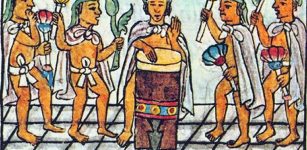 Daily Life Of Télpochcalli Students Of The Aztec Empire Was A Challenge
Ancient History Facts | Apr 20, 2020
Daily Life Of Télpochcalli Students Of The Aztec Empire Was A Challenge
Ancient History Facts | Apr 20, 2020 -
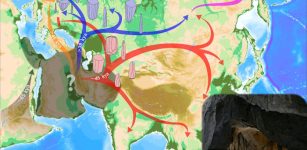 Mystery Of The East Asian Lineages In Europe 45,000 Years Ago Solved – Population Hub Out Of Africa Holds The Clues
Archaeology | Apr 7, 2022
Mystery Of The East Asian Lineages In Europe 45,000 Years Ago Solved – Population Hub Out Of Africa Holds The Clues
Archaeology | Apr 7, 2022 -
 Race Against Time: Crucial Expedition To Delve Into Bouldnor Cliff, Europe’s Mesolithic Underwater Stone Age Site
Underwater Discoveries | Apr 28, 2024
Race Against Time: Crucial Expedition To Delve Into Bouldnor Cliff, Europe’s Mesolithic Underwater Stone Age Site
Underwater Discoveries | Apr 28, 2024 -
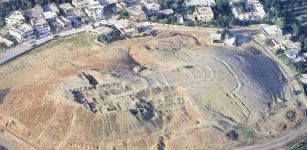 Iron Age Site Tell Deir ‘Alla (“Mound Of The High Monastery”) Flourished 400 Years In Central Jordan Valley
Archaeology | Jul 25, 2022
Iron Age Site Tell Deir ‘Alla (“Mound Of The High Monastery”) Flourished 400 Years In Central Jordan Valley
Archaeology | Jul 25, 2022 -
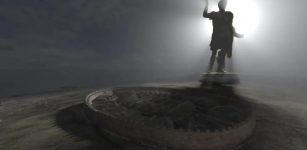 Mystery Of The Sandby Borg Massacre Deepens – Unexplained Disappearance Of Women
Featured Stories | Dec 5, 2020
Mystery Of The Sandby Borg Massacre Deepens – Unexplained Disappearance Of Women
Featured Stories | Dec 5, 2020 -
 People Of India In Focus: Where Did They Come From?
Civilizations | May 11, 2017
People Of India In Focus: Where Did They Come From?
Civilizations | May 11, 2017 -
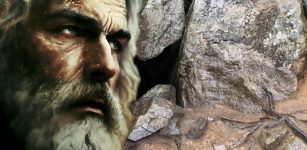 Why Did Sages And Shamans Repeatedly Visit The Mysterious Finnish Pirunkirkko Cave (Devil’s Church)?
Archaeology | Nov 27, 2023
Why Did Sages And Shamans Repeatedly Visit The Mysterious Finnish Pirunkirkko Cave (Devil’s Church)?
Archaeology | Nov 27, 2023 -
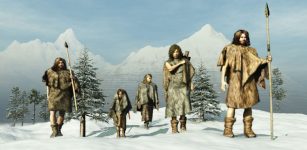 Climate Change Behind Early Human Migration To The Americas At Key Intervals – Scientists Say
Archaeology | Feb 17, 2023
Climate Change Behind Early Human Migration To The Americas At Key Intervals – Scientists Say
Archaeology | Feb 17, 2023 -
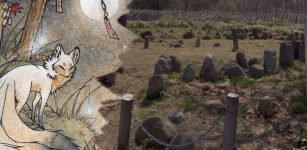 Did Ancient Oshoro Stone Circle Serve As A Portal To The Spirit World?
Featured Stories | Aug 19, 2017
Did Ancient Oshoro Stone Circle Serve As A Portal To The Spirit World?
Featured Stories | Aug 19, 2017 -
 3D-printed replica of an artefact revives music of Iron-Age Ireland
News | Sep 4, 2015
3D-printed replica of an artefact revives music of Iron-Age Ireland
News | Sep 4, 2015 -
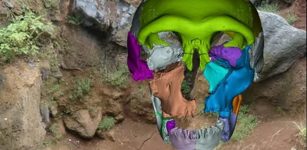 Unusual 300,000-Year-Old Jawbone May Belong To An Unknown Vanished Human Lineage
Archaeology | Dec 18, 2023
Unusual 300,000-Year-Old Jawbone May Belong To An Unknown Vanished Human Lineage
Archaeology | Dec 18, 2023 -
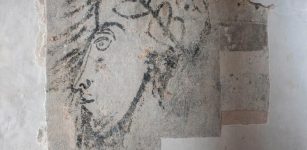 Sir Walter Raleigh ‘Self-Portrait’ Discovered Behind Walls In The Tower Of London
Archaeology | Nov 5, 2018
Sir Walter Raleigh ‘Self-Portrait’ Discovered Behind Walls In The Tower Of London
Archaeology | Nov 5, 2018 -
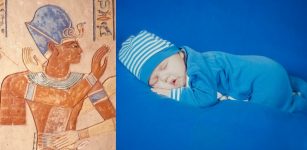 Ancient People Dressed Baby Boys In Blue To Ward Off Evil Spirits
Ancient History Facts | Mar 5, 2019
Ancient People Dressed Baby Boys In Blue To Ward Off Evil Spirits
Ancient History Facts | Mar 5, 2019 -
 Remains of Maurya-Era Wall Discovered In Tilaurakot, Kapilvastu, Nepal
Archaeology | Jun 16, 2022
Remains of Maurya-Era Wall Discovered In Tilaurakot, Kapilvastu, Nepal
Archaeology | Jun 16, 2022 -
 Scientific Disagreement Over The Bronze Age Tin Ingots From The Uluburun Shipwreck
Archaeology | Sep 25, 2023
Scientific Disagreement Over The Bronze Age Tin Ingots From The Uluburun Shipwreck
Archaeology | Sep 25, 2023 -
 Did Lead Poisoning Cause The Fall Of The Roman Empire?
Archaeology | Oct 24, 2017
Did Lead Poisoning Cause The Fall Of The Roman Empire?
Archaeology | Oct 24, 2017 -
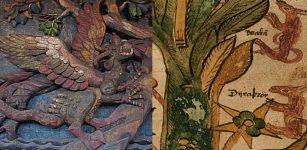 Magical And Malicious Creatures That Prey Upon Yggdrasil In Norse Beliefs
Featured Stories | Dec 6, 2019
Magical And Malicious Creatures That Prey Upon Yggdrasil In Norse Beliefs
Featured Stories | Dec 6, 2019 -
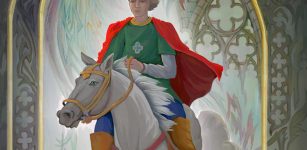 King Lud – Mysterious Founder Of London And His Connection To The Tuatha De Danann
Featured Stories | Oct 21, 2021
King Lud – Mysterious Founder Of London And His Connection To The Tuatha De Danann
Featured Stories | Oct 21, 2021 -
 Humans Were Living Around Fort McMurray, Alberta 13,000 Years Ago – Scientists Reveal
Archaeology | Aug 3, 2022
Humans Were Living Around Fort McMurray, Alberta 13,000 Years Ago – Scientists Reveal
Archaeology | Aug 3, 2022

